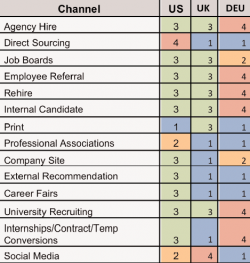 What sourcing channels should we invest in?
What sourcing channels should we invest in?
That’s one question we at Quintiles Global Staffing are trying to figure out. It resulted in the development of a tool we talk about in an upcoming Journal of Corporate Recruiting Leadership. We plan to use this tool on an ongoing basis, and I wanted to give you a taste of it here.
First, who we are. Quintiles is the only fully integrated bio and pharmaceutical services provider offering clinical, commercial, consulting and capital solutions. We have 23,000 employees in 60 countries. Quintiles Staffing, made up of approximately 50 teammates globally, assisted with a total of 16,390 hires in the past three years. Our internal development stands as a point of pride, as approximately 20% of all hires now are internal.
Some of our tasks at the moment include the development of an early talent pipeline, metrics refinement, extending partnership models, linking with executive succession planning, an effective employee referral program, and the implementation of a world-class applicant tracking system.
What Works and What Doesn’t
Recruiting organizations continue to use many sourcing channels, often with little consideration of the overall ROI of those channels. In fact, most recruiting executives find more than 25% of their sourcing channels to be ineffective. This not only causes unnecessary expense, but also adds to the number of unqualified applications received.
To avoid this, we developed criteria to rank sourcing channels, and asked ourselves how well the sourcing channel currently performs against each criteria. We rated on a scale of 1 to 5, where 1 is Poor and 5 is Excellent.
This report (which the Corporate Leadership Council helped with by providing the original toolkit) was for informational purposes — and not direct budget allocation decisions. The staffing leaders received this data, and then decided whether they thought it was credible or not. What I’m saying is that it’s not a sole decision driving force, but part of our decision making.
As I mentioned, we get into this more in the Journal of Corporate Recruiting Leadership, but for now, let me show you the chart (click to enlarge) we ended up with for the U.S., UK, and Germany.
